Replacing Oil Pan Bolts for Improved Engine Performance and Reliability
Oil Pan Bolt Replacement A Step-by-Step Guide
Maintaining a vehicle is essential for its longevity, and one critical component that often gets overlooked is the oil pan. The oil pan plays a vital role in ensuring that your engine runs smoothly by holding the engine oil and providing a reservoir for oil circulation. Over time, the oil pan bolts may become loose, corroded, or damaged, leading to oil leaks and potential engine damage. Replacing these oil pan bolts is an important maintenance task that can save you from costlier repairs down the line.
Tools and Materials Needed
Before you commence the replacement process, gather the necessary tools and materials
1. Socket Wrench Set Ensure you have the correct size of sockets for your vehicle's oil pan bolts. 2. Torque Wrench This is crucial for tightening the bolts to the manufacturer’s specified torque. 3. New Oil Pan Bolts Purchase quality replacements suited for your make and model. 4. Gasket or RTV Sealant If the gasket is damaged, you’ll need a new one or an appropriate sealant. 5. Oil Catch Pan To collect any oil that may spill during the replacement process. 6. Rags and Cleaners For cleaning the oil pan and surrounding areas.
Step-by-Step Replacement Process
1. Preparation Park your vehicle on a flat surface and engage the parking brake. Allow the engine to cool down and gather all tools. Using the oil catch pan, drain the engine oil as per your vehicle's procedure.
2. Access the Oil Pan Depending on the vehicle, you might need to raise it using jack stands. If there are any components obstructing access to the oil pan, such as the exhaust or suspension parts, carefully remove them.
3. Remove the Old Bolts Start removing the old oil pan bolts using the socket wrench. It's advisable to remove the bolts in a crisscross pattern to prevent warping the oil pan. Keep track of each bolt and any washers or spacers.
oil pan bolt replacement

4. Inspect the Oil Pan and Gasket Once the bolts are removed, inspect the oil pan for any signs of damage or corrosion. If the gasket looks worn or damaged, it will need replacing as well.
5. Clean the Surfaces Use a rag and cleaner to wipe down the mating surfaces on both the oil pan and the engine block. Ensure that all remnants of the old gasket or sealant are removed for a proper seal with the new gasket.
6. Install the New Gasket If applicable, install the new gasket onto the oil pan. If using RTV sealant, apply a uniform bead to the edge before mounting the pan.
7. Attach the New Bolts Position the oil pan back onto the engine block, ensuring it’s aligned properly. Begin hand-tightening the new bolts, then use your torque wrench to tighten them to the manufacturer’s specifications, following a crisscross pattern again.
8. Reassemble and Refill If you had to remove parts to access the oil pan, reattach them. Carefully refill the engine with fresh oil, checking for any leaks around the oil pan.
9. Final Check Start the engine and let it idle for a few minutes. Check for any leaks again. If everything looks good, take your vehicle for a short drive, then check the oil pan once more.
Conclusion
Replacing oil pan bolts is a straightforward maintenance task that can prevent significant engine issues. Regularly checking the condition of your oil pan and bolts, alongside other vehicle components, is crucial for ensuring your engine's health. By following this guide and addressing problems early, you can keep your vehicle running efficiently and avoid expensive repairs in the future.
-
The Ultimate Guide to Boat Propeller Bearings and Trailer Wheel Bearings
News Jul.31,2025
-
The Essential Guide to Marine Bearings and Boat Trailer Wheel Bearings
News Jul.31,2025
-
The Complete Guide to Heavy Duty Seals: Protecting Doors and Spaces Efficiently
News Jul.31,2025
-
Essential Guide to Marine Shaft Bearings and Boat Trailer Axle Bearings
News Jul.31,2025
-
Comprehensive Guide to Marine and Trailer Bearings for Safe Boating and Transport
News Jul.31,2025
-
Comprehensive Guide to Automotive Oil Seals: Protecting Your Engine and Shafts
News Jul.31,2025
-
Understanding Automotive Oil Seals: Essential Components for Engine and Shaft Protection
News Jul.30,2025
Products categories















